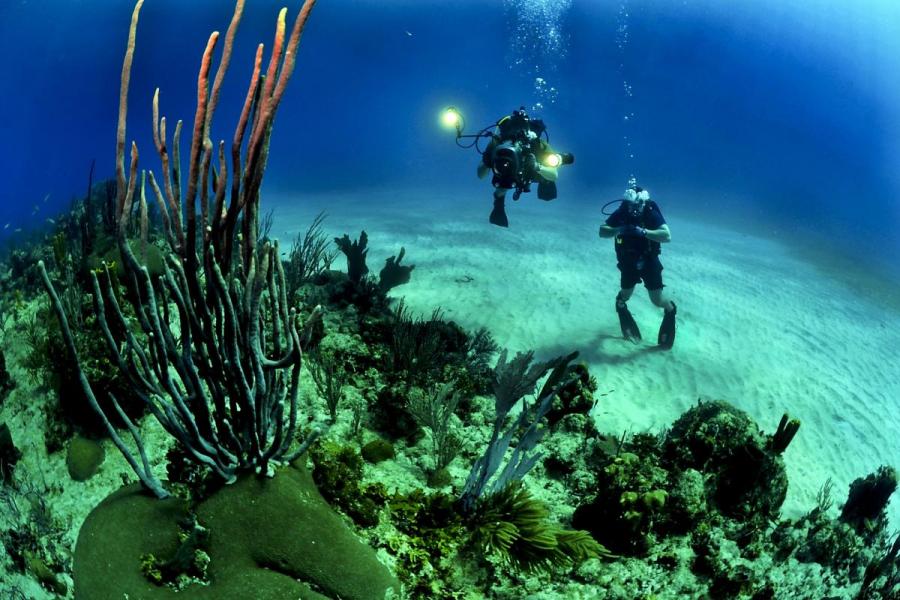
High Atmospheric Carbon Dioxide Levels Threaten Coral Reefs and People
As atmospheric carbon dioxide (CO2) levels rise, very few coral reef ecosystems will be spared the impacts of ocean acidification or sea surface temperature rise, according to a new analysis. The damage will cause the most immediate and serious threats where human dependence on reefs is highest.
In a new analysis in the journal PLOS One, led by members of a science team supported by the National Socio-Environmental Synthesis Center (SESYNC) at the University of Maryland, researchers from Duke University and the Université de Bretagne Occidentale used spatial data and analysis to understand the human impacts of ocean acidification. Using SESYNC’S computational resources, the team integrated the chemical, biological and human dimensions of ocean acidification to understand how high atmospheric carbon dioxide levels affect coral reefs. Their findings suggest that by 2050, Western Mexico, Micronesia, Indonesia, parts of Australia and Southeast Asia will bear the brunt of rising temperatures. Reef damage will result in lost fish habitats and shoreline protection, thereby jeopardizing the lives and economic prosperity of people who depend on reefs for tourism and food.
”Some scientists have held out hope that there would be reef areas that could escape the harm of climate change, but we find that most reefs will be affected by either warmer seas or more acidic oceans,” said Linwood Pendleton, the study’s lead author, a senior scholar at Duke University’s Nicholas Institute for Environmental Policy Solutions and an International Chair of Excellence at the European Institute of Marine Studies. “2016 has been one of the worst years in memory for coral bleaching. This fact is demonstrated by this year’s bleaching event that affected nearly all of the Great Barrier Reef.”
SESYNC facilitates new collaborations and provides computational support for critical efforts to address emerging problems--such as data and analysis of ocean acidification and how it impacts people--through interdisciplinary partnerships to designed to improve understanding. This study emerged from a SESYNC science team collaboration and builds on previous analyses to identify exactly how people and coral reefs are affected by a high-CO2 future and suggests pathways to help deal with changes. The authors mapped human dependence at the country level, scoring for two indicators: shoreline protection and coral reef fisheries. Simultaneously, the authors mapped the largely unavoidable impacts of increased sea surface temperature and ocean acidification.
Using data from the maps, the study predicts that the countries of Oceania will be among the first to face the greatest environmental stresses from climate change and ocean acidification, followed by the Coral Triangle countries of Southeast Asia and other parts of Australia -- all areas with high dependence on coral reefs.
Countries most likely to experience severe ocean acidification are generally different from those that will experience the earliest onset of coral bleaching. Acidification is projected to be worse for Baja California (Mexico), Japan, China, and southern Australia because they are at the upper and lower latitudinal bounds of coral reef distribution and thus generally in cooler waters that naturally carry more CO2.
“The response of non-governmental organizations, nonprofits, and labor and trade organizations will be critical in mounting a response to the threats posed by warming and acidification because these organizations represent the people that will be most severely impacted by the failure of coral reef fisheries,” said Chris Langdon, a professor in the Department of Marine Biology and Fisheries at the University of Miami. “These groups must speak up for the individuals they represent so that their local, regional and national government agencies see that action is needed.”
The authors say policy action to combat the threats of ocean acidification and surface temperature rise must be informed by data and science, but the research community is still doing a poor job of collecting this information where these threats are most substantial for people. Many of the countries most dependent upon coral reefs are also the countries for which we have the least robust data on ocean acidification, especially the South China Sea, an area of high human dependence and equally high political tensions.
“Because sea temperature and ocean acidification is largely beyond the control of the communities that depend on coral reefs, it is critical that we constantly monitor conditions there,” said Adrien Comte, a Ph.D. candidate at the Université de Bretagne Occidentale. “Better environmental management can help delay the impacts on corals, and stepwise actions to improve monitoring and plan for adaptation should be funded.”
View a summary of the findings and interactive Storymaps website. The article is availble on Duke University's Nicholas Institute for Environmental Policy and Solutions' website.
CITATION: L. Pendleton, A. Comte, C. Langdon, et. al. 2016. “Coral Reefs and People in a High CO2 World: Where Can Science Make a Difference to People?” PLOS ONE: DOI: 10.1371/journal.pone.0164699.
FUNDERS: This work was supported with grant funding from the National Socio-Environmental Synthesis Center (SESYNC), the Prince Albert II Foundation, the "Laboratoire d'Excellence" LabexMER (ANR-10-LABX-19), and the French government under the program "Investissements d'Avenir" and the Region of Brittany.
- - - - - - - - -
Note to broadcast editors: Broadcast reporters should contact Erin McKenzie to arrange an interview with Linwood Pendleton who is based in France, but can be available for interviews via Skype.
Duke University Media Contact:
Erin McKenzie
(919) 613-3652
erin.mckenzie@duke.edu
About SESYNC
SESYNC's mission is to support synthetic, actionable team science on the structure, functioning and sustainability of socio-environmental systems. The center’s five core objectives are to: enhance the effectiveness of interdisciplinary collaborations among natural and social science research teams focused on environmental problems; build capacity and new communities of socio-environmental researchers; provide education programs to enhance interdisciplinarity and understanding of socio-environmental synthesis; enhance computational capacity to promote socio-environmental synthesis; and enhance relevance of socio-environmental research to decisions and behaviors via actionable scholarship. For more information on SESYNC and its activities, please visit www.sesync.org.